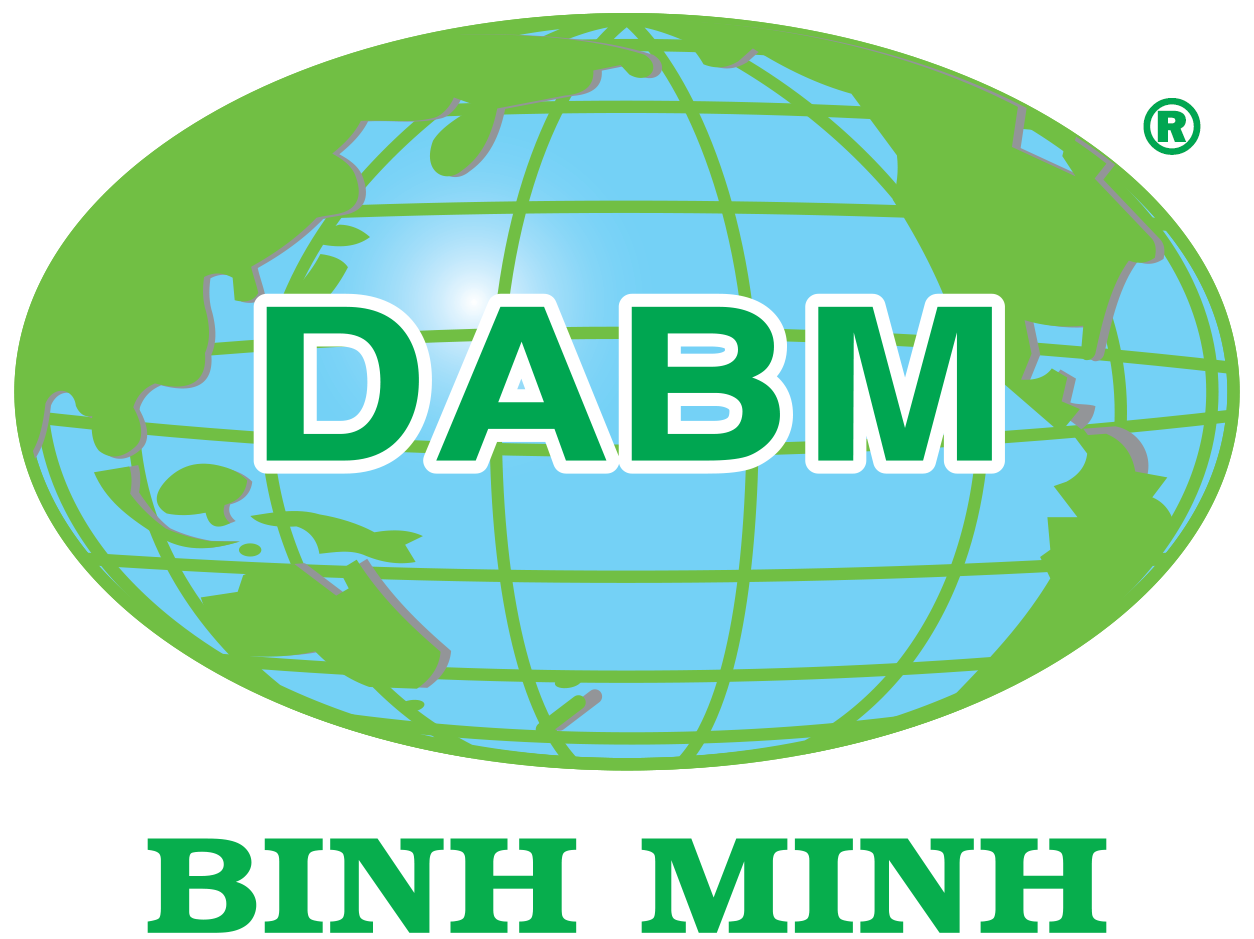3. Results
3.1. Pond Performance
3.1.1. Cyst Production.
Cyst harvesting started from DOC18, 17 days after stocking, at around 0.5kg/ha/day (Figure 4) and ceased after DOC94 because of a prolonged heatwave that resulted in detrimental water temperature and suboptimal salinities. From DOC17, cyst productivity remained lower than 1.0kg/ha/day across all the ponds till DOC27. The HIGHER group started to deviate from the LOWER one from DOC28 and clearly stayed above for the next 32 days until DOC60.For more than 60 days from DOC35 to DOC87 the average cyst productivity of the HIGHER group was 2.0 folds higher than that of the LOWER one. Pond 8 in the LOWER group crashed completely on DOC35 after 14 days yielding 1.0kg/ha/day. Overall, the total amount of cysts harvested from the HIGHER group was 2.5 folds higher than that from the LOWER group.

Note: Data are means ±S.E.M. Within a row means with different superscript letters are significantly different (p <0:05).
Cyst productivity of the HIGHER group was 1.8 folds higher than that of the LOWER group (p<0,05) (Table 2). For both pond groups there were two peaks in cyst production during our study period of 111 days (Figure 4). The first peak was more pronounced for the HIGHER group, starting from DOC47 and lasted for 6–7 days in all the other ponds. Average daily cyst productivity during this period was 4.0kg/ha/day, three folds higher than that of the LOWER group. The second peak of cyst productivity was observed between DOC80 and DOC89. It was longer for the LOWER group, but cyst productivity sharply dropped after DOC90 due to extreme temperature. Daily cyst productivity in the second peak was only 68%of the first peak for the HIGHER group.
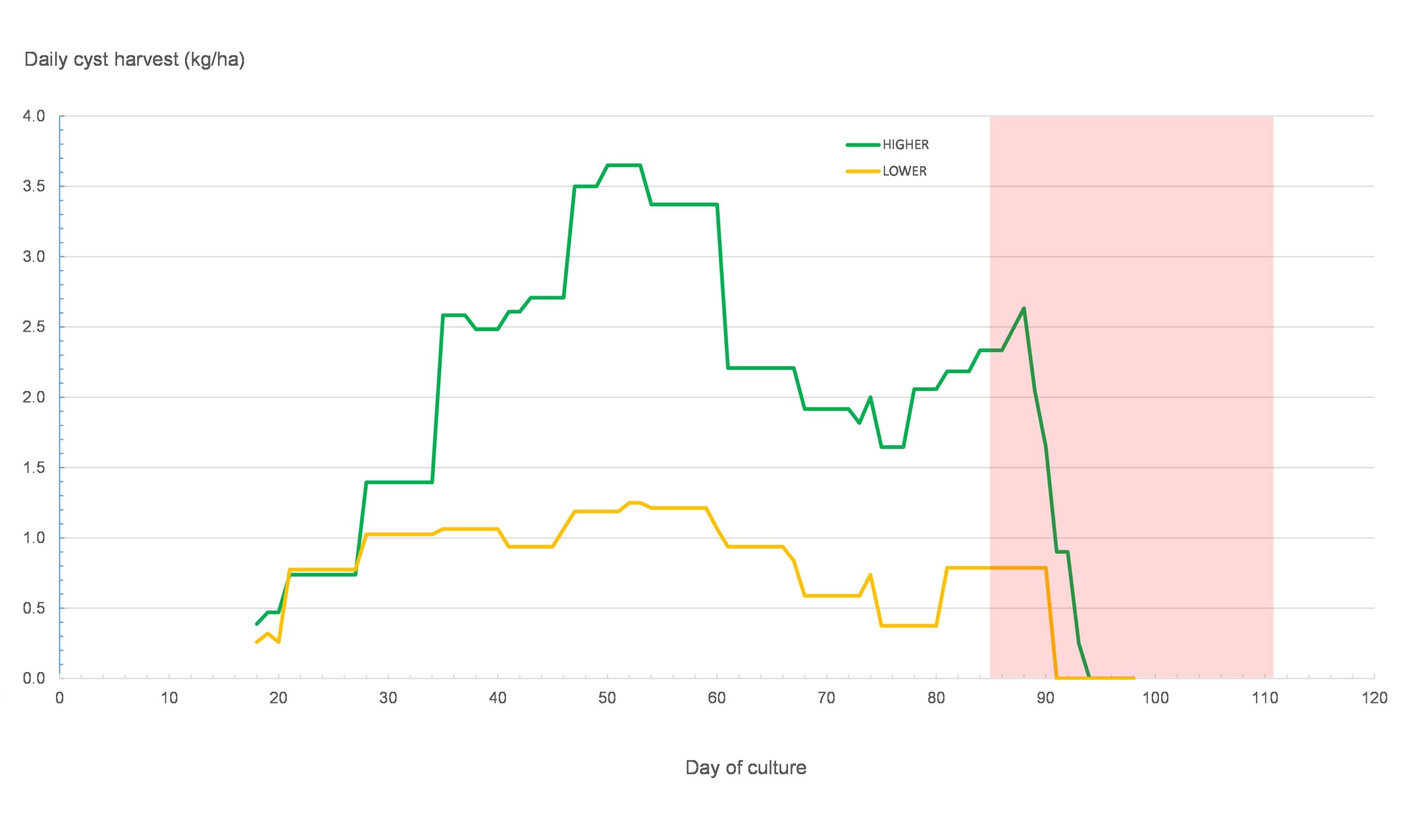
3.1.2. Pond Inputs and Conversion-to-Cyst Efficiency.
Chicken manure was applied from DOC3 to DOC104 while supplementary feeding with shrimp feed crumbles only started from DOC20 or 2 days after the start of cyst collection (Figure 5). The application rate of chicken manure did not show any patterns over the experimental period and was not different between the two pond groups. Often, a higher dosage was followed by a lower dosage. In contrast, the feeding rate increased over time from DOC20 to DOC70. A higher feeding rate was recorded consistently in the HIGHER group to sustain larger Artemia biomass (p<0.05). During that period of 50 days the amount of feed used for the HIGHER and LOWER groups was 201.7 and 77.5kg, respectively. During the first peak of Artemia cyst production, the HIGHER group received 74.5kg of feed or 3.5 folds higher than the LOWER group (21.3kg). After 10 days of great fluctuation, the feeding rate increased from DOC78 and remained at a high level just prior to and during the second peak of Artemia cyst production from DOC83 to DOC89 (Figure 5).

The conversion ratio of chicken manure used to cysts (CCR) of the HIGHER group was only 8.4±0.9, significantly lower than that of the LOWER group (20.9±6.0) (p0.05), averaging 0.18–0.20 (Table 2). Regression analysis using data of eight individual ponds shows a strong correlation between cyst productivity and feeding rate or fertilization rate (p<0.05) (Figure 6). Increasing feeding rate from 0 to 75kg/ha/crop resulted in positive increments of cyst productivity. Similarly, cyst productivity responded positively to increasing fertilization rate from 1733 to 3500kg/ha.

3.2. Microbiome of Artemia Ponds
3.2.1. Bacterial Composition and Diversity.
PCoA was carried out to analyze the relationship between the sampling events and structural microbial communities from three sample types. Generally, the structure of microbial communities significantly discriminated by sample type rather than sampling event. Dis tinct bacterial communities were found among Artemia gut, pond water, and pond sediment regardless of sampling time or cyst productivity (Figure 7A). Temporal variation was significant only for pond water between the two samplings on DOC54 and DOC93.
Within pond water, samples trended to distanced by sampling event, showing time-specific differences in the microbial composition compared with the pond sediment. The factor sampling event and cyst productivity explained a higher pro portion of the variance for pond water samples (69.0%)than for pond sediment samples (56.9%) (Figure 7B, C). For the Artemia gut, samples were segregated by sampling event, explaining a remarkably high percentage of variance (80.1%) and indicating the bacterial community of Artemia gut was varied over the culture time (Figure 7D). However, the number of Artemia gut samples at the end-of-crop was insufficient (only three samples) to compare with the Artemia gut samples at the mid-crop. Bacterial communities of Artemia gut, pond water, and pond sediment were similar between the two pond groups HIGHER and LOWER classified by cyst productivity. However, the level of similarity increased in order from Artemia gut to pond sediment and then pond water.
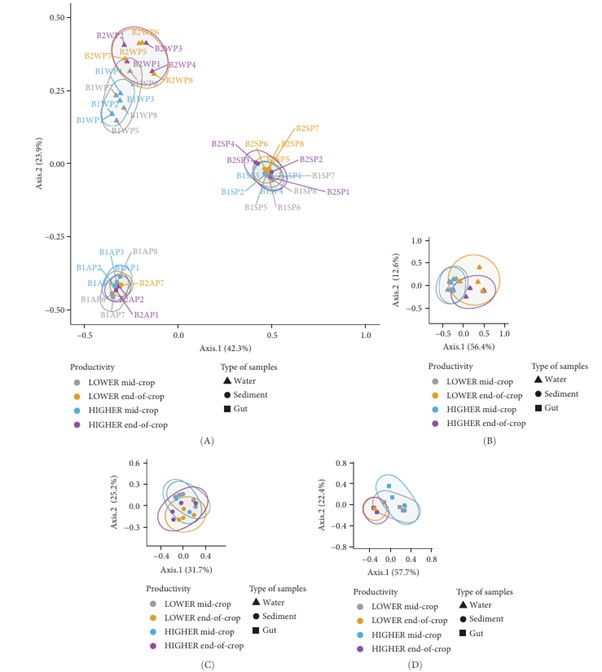
Alpha diversity was highest for pond sediment and lowest in Artemia gut (p<0:05) (Figure 8). Alpha diversity of pond sediment was approximately six and eight folds higher than that of pond water and Artemia gut, respectively. Temporal variation of alpha diversity was highest for pond water and lowest for Artemia gut. For pond sediment, higher alpha diversity was associated with higher cyst productivity. However, this association was not observed for pond water and Artemia gut. Bacteria diversity in Artemia gut was found conservative over time and did not vary with cyst productivity.
Pond sediment had the highest diversity compared to pond water and Artemia gut reflected by the number of taxa detected (Figure 8). Furthermore, the bacteria communities of pond sediment were much more stable over time, while significant shifts were found for pond water and Artemia gut between mid-crop (the first sampling) and end-of-crop (the second sampling). Anaerolineae—an anaerobic group was the dominant taxon in pond sediment. The other dominant taxa in pond sediment were Promineofilaceae, Rhodosalinus, and Rhodobacteraceae. At mid-crop the relative abundance of Anaerolineae was higher in the LOWER pond group(17.4%) compared with the HIGHER one (9.7%). However, no difference in relative abundance of Anaerolineae was observed at the end of the crop, that is around 12.6%–12.9% in both pond groups. Interestingly, Roseovarius’s abundance in pond sediment was minor and did not up to change over time or with cyst productivity. In contrast, Roseovarius was the dominant taxon in pond water and especially in Artemia gut. Across all the experiment ponds, those with higher cyst productivy had apparently higher bacteria diversity and at the same time less Anaerolineae’s abundance in the sediment (Figure 8).
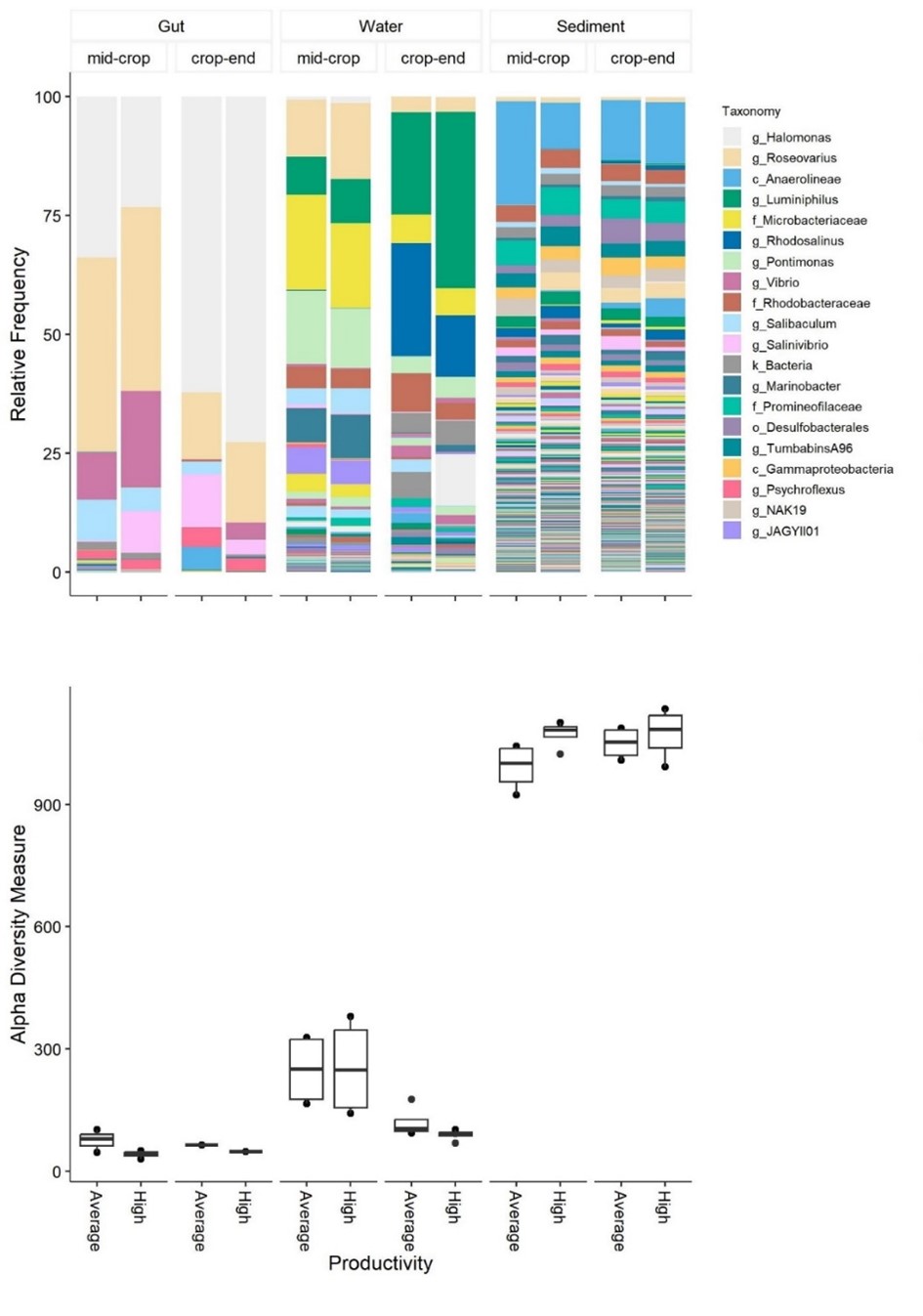
In pond water, the dominant taxa at mid-crop included Microbacteriaceae (17.8%–20.0%), Pontimonas (12.5%–15.4%), Roseovarius (11.9%–15.9%), and to lesser magnitude, Marinobacter, Luminiphilus, Desulfobacterales, and Rhodobacteraceae. However, except for Luminiphilus and Rhodobacteraceae, their abundance significantly reduced at the end of the crop. Luminiphilus became the dominant taxon (21.5%–37.1%), followed by Rhodosalinus (12.9%–23.8%) which only presented at 0.18% mid-crop. Only for the HIGHER pond group Halomonas was the third dominant taxon in pond water.
The dominant bacterial taxa in Artemia gut around mid crop included Roseovarius (38.7%–40.8%), Halomonas (23.3%–33.9%), and Vibrio (10.0%–20.1%) around mid-crop at salinity of 115–120ppt (Figure 9). Halomonas abundance increased to 62.3%–72.7% at the end of the crop when salinity was 154–158ppt. In contrast, as salinity increased to 154 158ppt, the relative abundance of both Vibrio and Roseovarius significantly reduced at the end of the crop. Between the two pond groups, the relative abundance of Vibrio was two folds higher in the HIGHER pond group compared with the LOWER one. Pond with higher abundance of Vibrio and lower abundance of Roseovarius in Artemia gut tended to have higher cyst productivity (Figure9). Salinivibrio was adominant taxon in Artemia gut at mid-crop only in one pond of the HIGHER pond group (8.76%), but this taxon was commonly found across the pond sat the end of the crop (11.13% in LOWER pond group and 3% in HIGHER pond group). For the LOWER pond group only, Anaerolineae and Psychroflexus (4.18%) were the other dominant taxa at the end of the crop.
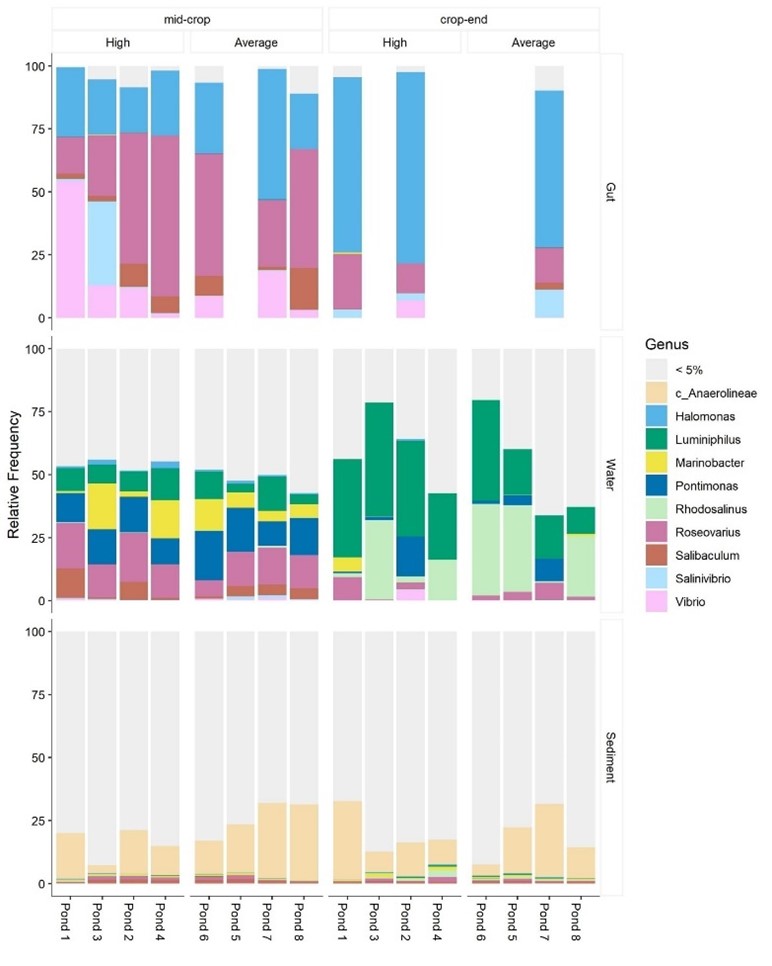
3.2.2. Microeukaryotic Communities.
The PcoA plot showed a distance in the microeukaryote communities of pond sediment, pond water, and Artemia gut between the two sampling events but exhibited significant similarities between the two cyst productivity pond groups in pond water and, to a lesser extent, pond sediment at each sampling event (Figure10A). Further more, samples within HIGHER pond group at mid-crop were more clustered, indicating the microeukaryotic composition was less varied compared to that of the end-of-crop. The pond water was clearly aggregated by sampling event with the components explained 74.3% variance (Figure10B). The microeukaryote communities of pond water in ponds still with Artemia cysts at the end of the crop (Pond 1 and Pond 2 of the HIGHER group and Pond 7 of the LOWER group) were distinguished from the rest, indicating the occurrence of a significant shift. Similarly, for pond sediment, the ponds clustered well at mid-crop regardless of cyst productivity. In particular, the PcoA plot showed an overlap between samples from the mid-crop and the end-of crop with 45.5% variance explained (Figure10C). However, at the end of the crop, discrepancies were observed between the two pond groups. The LOWER group departed much more than the HIGHER one from their previous status. Although the components for Artemia gut explained 89.2% of the total variance (Figure 10D), limited number of qualified samples of Artemia gut did not allow any clear interpretation.
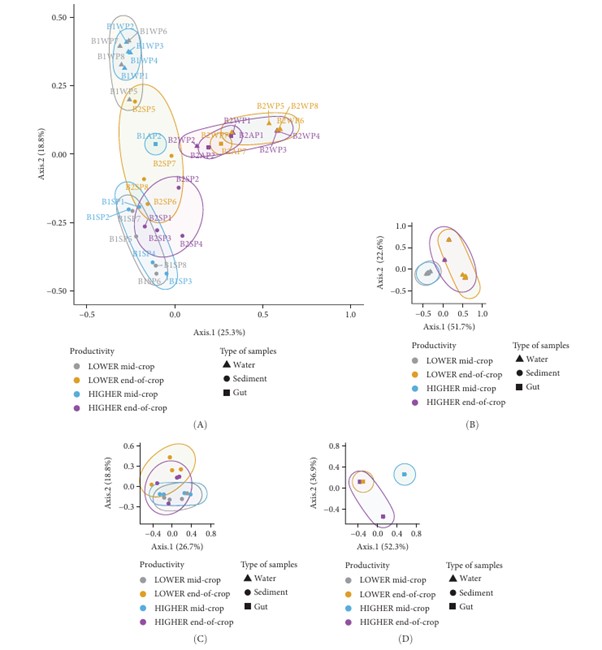
Overall, microeukaryotic diversity was highest in pond sediment, followed by pond water and Artemia gut regardless of sampling time and cyst productivity (p<0:05) (Figure 11). Significant reduction of microeukaryotic diversity was observed at the end of the crop for pond water and Artemia gut in both cyst-productivity pond groups (p<0:05) but was minor for pond sediment. Spirotrichea, Bacillariophyceae, Chlorophyceae, Fungi, and Trebouxiophyceae were the end of the crop in three ponds that still had Artemia (Pond 1 and Pond 2 of the HIGHER group and Pond 7 of the LOWER group), but in pond sediment (Figure 12). The other dominant taxa in pond water at mid-crop such as Spirotrichea, Fungi, and Raphidophyceae almost disappeared at the end of the crop. Ponds with higher cyst productivity had more Bacillariophyceae and Raphidophyceae. In Artemia gut, the most dominant taxon at mid-crop was Bacillariophyceae (18.86%), followed by Fungi (14.99%) and Sordariomycetes (3.1%). At the end of the crop, only Fungi remained one of the dominant taxa. The other dominant taxa included Malasseziomycetes, Wallemiomycetes, Eurotiomycetes, and Agarimycetes. Regarding cyst productivity, both Bacillariophyceae and Chlorophyceae were present in the LOWER group and HIGHER group, respectively, but at minimal level of abundance.

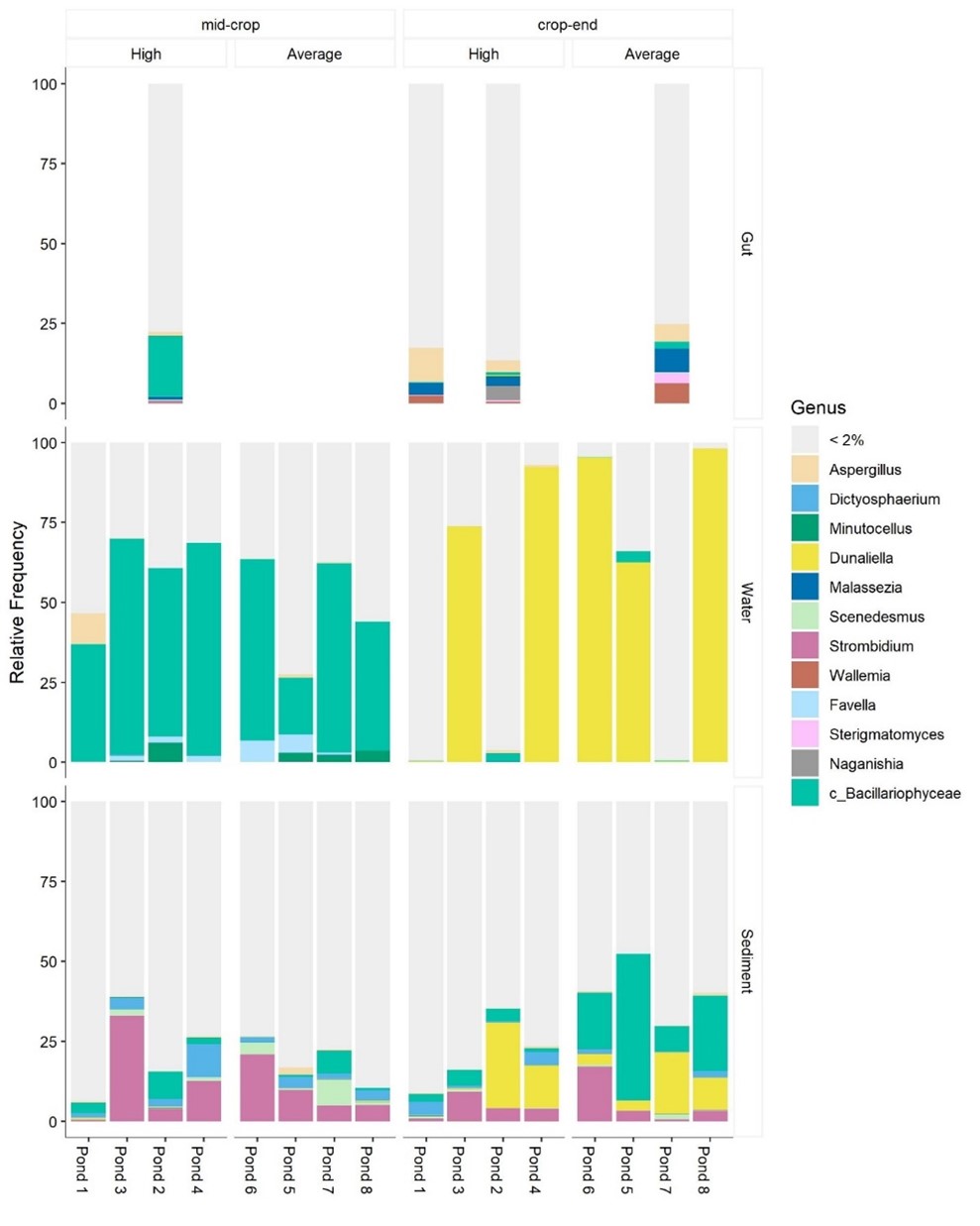
… To be continued …
By Tung Hoang, Nguyen Thai Binh, Vo Thi Minh Thu, Tran Thi Hong Tham, Tran Minh Long
Read more:
- Optimizing tilapia biofloc technology systems, part 1
- Optimizing tilapia biofloc technology systems, part 2
- Evaluation of single cell protein on the growth performance, digestibility and immune gene expression of Pacific white shrimp, Penaeus vannamei

 Tiếng Việt
Tiếng Việt 中文 (中国)
中文 (中国)